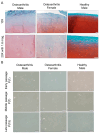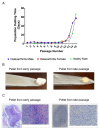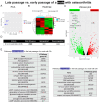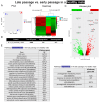Transcriptomic Changes During the Replicative Senescence of Human Articular Chondrocytes
- PMID: 39596199
- PMCID: PMC11594096
- DOI: 10.3390/ijms252212130
Transcriptomic Changes During the Replicative Senescence of Human Articular Chondrocytes
Abstract
Aging is a major risk factor for osteoarthritis (OA), but the specific mechanisms connecting aging and OA remain unclear. Although chondrocytes rarely divide in adult articular cartilage, they undergo replicative senescence in vitro, offering a model to study aging-related changes under controlled conditions. OA cartilage was obtained from an 80-year-old male and a 72-year-old female, while normal cartilage was sourced from a 26-year-old male. Chondrocyte cultures were established and sub-cultured to their Hayflick limit. Bulk RNA sequencing on early- and late-passage human articular chondrocytes identified transcriptomic changes associated with cellular aging. Early-passage OA chondrocytes already showed senescent phenotypes, unlike normal chondrocytes. All three cultures underwent 30 population doublings before replicative exhaustion, at which point all cells displayed senescence. During this process, cells lost their ability to form cartilaginous pellets. Differential gene expression analysis revealed distinct transcriptomic profiles between early- and late-passage chondrocytes and between normal and OA-derived cells. Genes related to matrix synthesis, degradation, inflammation, and the senescence-associated secretory phenotype (SASP) showed significant expression changes. Despite being a small pilot study, these findings suggest that further research into the molecular and metabolic changes during chondrocyte senescence could provide valuable insights into OA pathobiology.
Keywords: Hayflick limit; aging; chondrocyte replicative senescence; osteoarthritis; transcriptomics.
Conflict of interest statement
The authors declare no conflicts of interest.
Figures









Update of
-
Transcriptomic changes during the replicative senescence of human articular chondrocytes.bioRxiv [Preprint]. 2023 Nov 7:2023.11.07.565835. doi: 10.1101/2023.11.07.565835. bioRxiv. 2023. Update in: Int J Mol Sci. 2024 Nov 12;25(22):12130. doi: 10.3390/ijms252212130. PMID: 37986862 Free PMC article. Updated. Preprint.
Similar articles
-
Transcriptomic changes during the replicative senescence of human articular chondrocytes.bioRxiv [Preprint]. 2023 Nov 7:2023.11.07.565835. doi: 10.1101/2023.11.07.565835. bioRxiv. 2023. Update in: Int J Mol Sci. 2024 Nov 12;25(22):12130. doi: 10.3390/ijms252212130. PMID: 37986862 Free PMC article. Updated. Preprint.
-
Expression of p16INK4a is a biomarker of chondrocyte aging but does not cause osteoarthritis.Aging Cell. 2018 Aug;17(4):e12771. doi: 10.1111/acel.12771. Epub 2018 May 9. Aging Cell. 2018. PMID: 29744983 Free PMC article.
-
MiR-653-5p drives osteoarthritis pathogenesis by modulating chondrocyte senescence.Arthritis Res Ther. 2024 May 29;26(1):111. doi: 10.1186/s13075-024-03334-5. Arthritis Res Ther. 2024. PMID: 38812033 Free PMC article.
-
Aging and osteoarthritis: the role of chondrocyte senescence and aging changes in the cartilage matrix.Osteoarthritis Cartilage. 2009 Aug;17(8):971-9. doi: 10.1016/j.joca.2009.03.002. Epub 2009 Mar 12. Osteoarthritis Cartilage. 2009. PMID: 19303469 Free PMC article. Review.
-
The Role of Chondrocyte Hypertrophy and Senescence in Osteoarthritis Initiation and Progression.Int J Mol Sci. 2020 Mar 29;21(7):2358. doi: 10.3390/ijms21072358. Int J Mol Sci. 2020. PMID: 32235300 Free PMC article. Review.
Cited by
-
The intersection of aging and estrogen in osteoarthritis.NPJ Womens Health. 2025;3(1):15. doi: 10.1038/s44294-025-00063-1. Epub 2025 Feb 25. NPJ Womens Health. 2025. PMID: 40017990 Free PMC article. Review.
References
MeSH terms
Grants and funding
LinkOut - more resources
Full Text Sources
Medical
Molecular Biology Databases

